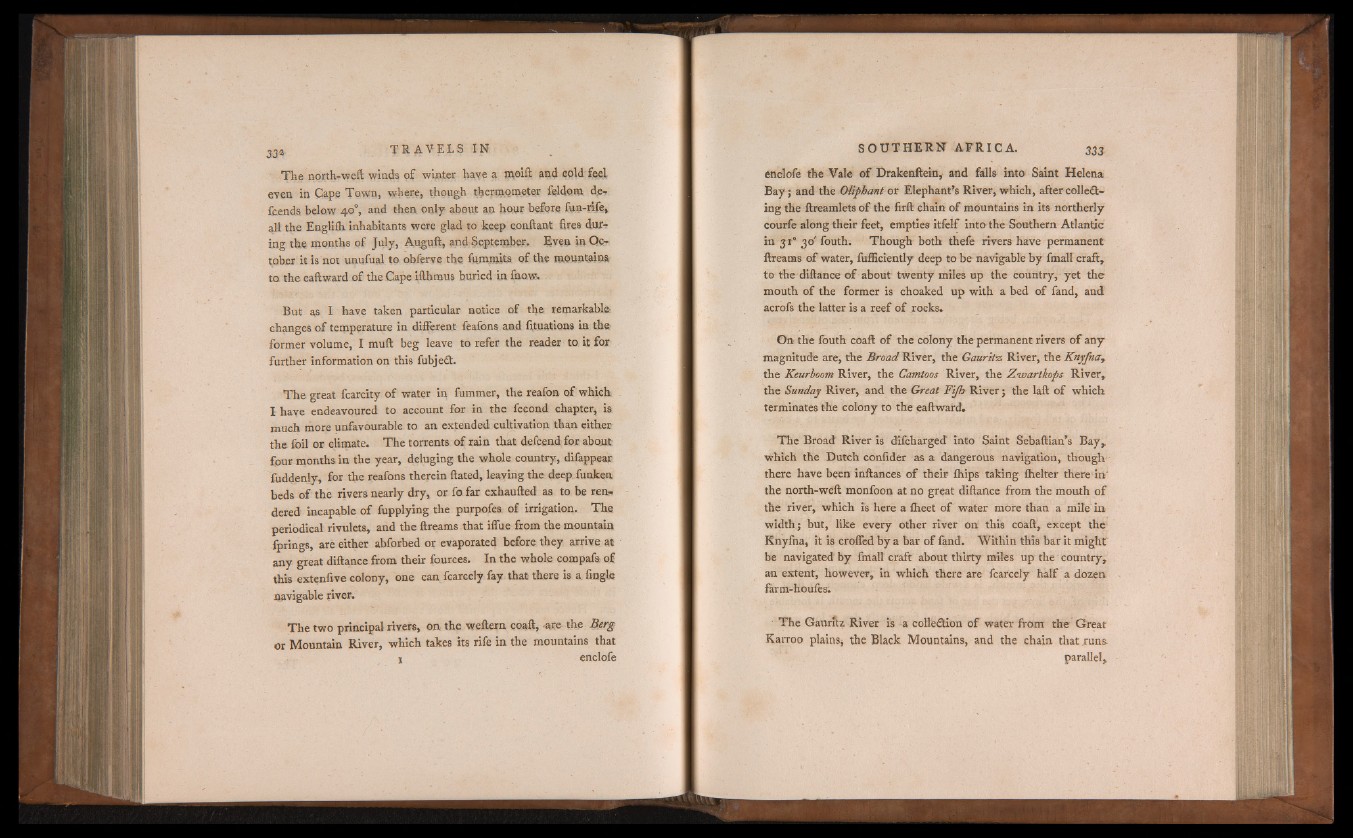
The north-weft winds of winter have a ovoid and cold feel
even in Cape Town, where, though thermometer feldom de-.
fcends below 40°, and then only about an hour before fun-rife*
all the Engliih inhabitants were glad to keep eonftant fires dur-»
ing the months of July, Auguft, and September. Even in October
it Is not unufual to obferve the fummits of the mountains
to the eaftward of the Gape ifthrous buried in fnow.
But as I have taken particular notice of the remarkable
changes of temperature in different feafons and fituations in the
former volume, I muft beg leave to refer the reader to it far
further information on this fubjeCt.
The great fcarcity of water in fummer, the reafon of which
I haye endeavoured to account for in the fecond chapter, is
much more unfavourable to an extended cultivation than either
the foil or climate. The torrents of rain that defcend for about
four months in the year, deluging the whole country, difappear
fuddenly, for the reafons therein ftated, leaving the deep funken
beds o f the rivers nearly dry, or fo far exhaufted as to be ren-,
dered incapable of fupplying the purpofes of irrigation. The
periodical rivulets, and the ftreams that iflue from the mountain,
fprings, are either abforbed or evaporated before they arrive at
any great diftance from their fources. In the whole compafs of
this extenfive colony, one can fcarcely fay that there is a. fingls
navigable river.
The two principal rivers, on the weftern coaft, -are the Berg
or Mountain River, which takes its rife in the mountains that
x enclofe
enclofe the Vale of Drakenftein, and falls into Saint Helena
Bay; and the Oliphant or Elephant’s River, which, after colleCt-
ing the ftreamlets of the firft chain of mountains in its northerly
courfe along their feet, empties itfelf into the Southern Atlantic
in 3 r' 30' fouth. Though both thefe rivers have permanent
ftreams of water, fufficiently deep to be navigable by finall craft,
to the diftance of about twenty miles up the country, yet the
mouth of the former is choaked up with a bed of fand, and
acrofs the latter is a reef of rocks.
On the fouth coaft of the colony the permanent rivers of any
magnitude are, the Broad River, the Gaur'ttz River, the Kny/nay
the Keurboom River, the Camtoos River, the Zvoarthops River,
the Sunday River, and the Great Fijk River; the laft of which
terminates the colony to the eaftward.
The Broad River is difcharged into Saint Sebaftian’s Bay,
which the Dutch confider as a dangerous navigation, though
there have been inftanees of their ihips taking fhelter there in'
the north-weft monfoon at no great diftance from the mouth of
the river, which is here a fheet of water more than a mile in
width ; but, like every other river on this coaft, exGept the
Knyfna, it is crofted by a bar of fend. Within this bar it might
be navigated by final! craft about thirty miles up the country,
an extent, however, in which there are fcarcely half a dozen
farm-houfes.
The Gaurftz River is a collection of water from the Great
Karroo plains* the Black Mountains, and the chain that runs
parallel,